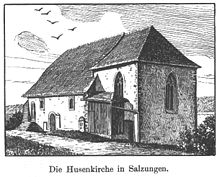Husenkirche (Bad Salzungen)
The Husenkirche was the first parish church in today's town of Bad Salzungen and was located in the medieval suburb of Hausen , about 500 meters west of the castle complex. Today only the rising masonry remains of the church, which was badly damaged at the end of the war.
location
The Husenkirche is located in the eastern part of the city cemetery on Leimbacher Straße, an inner-city section of the B 62 in the west of Bad Salzungen.
history
Today's Husenkirche was first mentioned in a document in 1258. This still existing structure was built in the Gothic style. The history of the church begins as early as the 8th century, when the Hersfeld Monastery built the Husenkirche, probably the first Christian cult site in the Salzunger Mark, and consecrated it to St. George . At first, as long as they did not have their own houses of worship, all parishes in the Mark were parish into this church and remained with it in the branch association for a long time even after it was built . The little church, built as a simple wooden church, is said to have been replaced by a first stone building in 1101, which was done at the instigation of the Hersfeld abbot Willibald .
Barely 500 meters from the location of the Husenkirche, the village of Salzungen developed into the main settlement of the valley and later into a town. The Husenkirche thus lost its priority and the parish previously allocated to the Husenkirche was transferred to the Simpliciuskirche in Salzung . In 1341 the Archbishop of Mainz , to whose diocese the Salzunger Kirchensprengel belonged, transferred the administration to the neighboring Frauensee Monastery , which from then on occupied the pastoral position until the Reformation .
The parents of Martin Luther , Hans Luder and Margarethe Lindemann, from nearby Möhra , are said to have married in front of the Husenkirche (before 1483) and to have been consecrated in this church.
The village of Husen must still have existed in 1525, because an Andreas from Husen is said to have participated in the peasant uprising , in 1533 the parish of Husen was united with the Simplicius Church in the city by order of the Elector Johann von Sachsen , and the church, whose district was still in 1557 was surrounded by a protective wall and served as the Salzunger Friedhofskirche. The last pastor of Husen, Werner Ottwald, moved to the city when the Reformation was introduced.
During the last air raid on Bad Salzungen on March 31, 1945, the industrial site west of the city was chosen as the target, a random ammunition train was hit, and the blast wave of the detonation also caused the roof of the Husenkirche to collapse. Just four days later, Bad Salzungen was in the hands of the Americans. Due to the severe damage to the church, the GDR administration failed to rebuild it, and the church was rededicated as a memorial to the Second World War . As a result of the weather, the building is increasingly falling into disrepair and is considered an urgent need for renovation.
Structural remains
The towerless church building made of local gray sandstone is a rectangular structure with a rectangular chancel on the east side. Here you can still see a large ogival window on the north and south sides with stone tracery in the shape of a fish bubble. Two narrow windows, which are covered with a keel arch , are located in the southern wall of the nave, further walled openings probably come from the first stone building after 1100. There is still a stone staircase on the west corner of the nave. The interior was modest. You can still find faded, weathered plaster residues on the inside of the church walls and some grave slabs. The wooden structures and the ceiling, which were still intact before the war, had late Gothic shapes. There is still a small sacrament niche in the north church wall, probably from around 1550–1600. This niche is framed by round bars that cut through at the top corners. The base of the round bars is twisted like a rope, a shape that is characteristic of this area for the period around 1600.
meaning
As the oldest building, the Husenkirche is of great importance for the history of the city and the church; it is also a memorial and a memorial to the history of the Second World War. The Husenkirche is also a monument within the meaning of the Thuringian Monument Protection Act .
literature
- Ludwig Hertel: Die Husenkirche In: Architectural and Art Monuments of Thuringia, Duchy of Saxony-Meiningen, Booklet XXXV District Court District Salzungen P. 19–24 Jena 1909.
- Hartmut Ruck: Chronicle Bad Salzungen Bad Salzungen (no year)
- Brückner: Regional Studies of the Duchy of Meiningen - Part Two - pp. 3–68
Web links
Individual evidence
- ↑ Thuringian Land Surveying Office TK350 overview map - Thuringia, Erfurt (from 1991)
- ^ Ludwig Hertel: Duchy of Saxony-Meiningen. Meiningen district. Bad Sakzungen administrative district . In: Paul Lehfeld and Georg Voss (eds.): Architectural and art monuments of Thuringia . Booklet XXXV. G. Fischer Verlag, Jena 1909, p. 19-24 .
Coordinates: 50 ° 48 ′ 50 ″ N , 10 ° 13 ′ 22 ″ E


